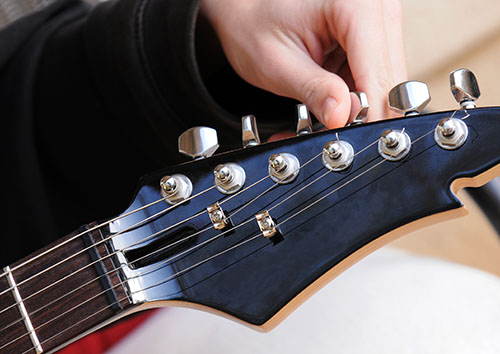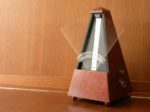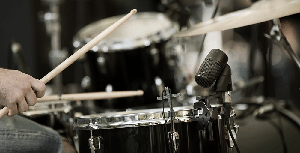In this expert-written guide on how to tune a guitar, you’ll learn everything you need to know about tuning a guitar, from tuners to tuning a guitar by ear to different types of guitar tuning.
Tuning your guitar is a fairly simple process that most guitar students learn during their first lesson. Let’s quickly look at how to tune up to the standard tuning first, then we’ll delve into different tunings, different digital tuners, and troubleshooting.

For those of you who are only interested in learning how to tune your guitar to the standard tuning, this first section is all you need. (You can read more about other tunings towards the end of this article.)
First things first, standard tuning has the strings tuned to the notes E-A-D-G-B-E. This means that the strings, starting from the thickest sixth string to the thinnest first string, are tuned to the musical notes of E-A-D-G-B-E (in that order). It is useful to remember this tuning, so using a mnemonic phrase like “Every Animal Does Good Behavior Exercises” can help.
The next step requires a tuner of some sort, so go ahead and grab one if you haven’t yet.
Let’s begin on the sixth string, which is the thickest string.
First, tune up or down until you reach the E note. Simply grab the corresponding tuning peg, and tighten or loosen it until your tuner displays the E note.
Next, most tuners have a bar or needle to tell you how far off your tuning is. Many tuners use a light to signal that your string is perfectly in tune.
You want the bar/needle to be dead center. If the bar/needle is off to the left, your string is flat, which means you need to tighten it. If the bar/needle is off to the right, your string is sharp, which means your need to loosen it.
Adjust until your tuning is dead center. Repeat this same process for the other five strings.
When you’re done with all your strings, check your tuning again and retune any strings that may have gone out.
How to tune a guitar with tuners
There are many kinds of analog and digital tuners out there to tune your guitars, but for the sake of simplicity, I normally stick to digital tuners. Here are three of the most common types of digital tuners.
Smartphone apps - The most convenient tuner is actually the smartphone in your pocket as there are hundreds of tuning apps available.
The one I recommend the most is GuitarTuna for iPhones and for Android phones.
There are downsides to these apps though; they rely on your phone’s microphone to pick up the sound, which means that if you’re in a noisy environment, you’re going to have a hard time getting the mic to pick up your guitar’s sound.
Clip-on - The next digital guitar tuner is the clip-on type. These are inexpensive devices that can be clipped onto the headstock of your guitar, and it can pick up the vibrations produced by the strings to let you know what note your string is tuned to.
They are really handy to have around, and are more accurate than microphone-based tuners like the smartphone apps.
They do have issues in very noisy rooms though. If the entire room is vibrating, or if you’re on a loud stage performing with other musicians, it’s likely your entire instrument is already vibrating, which could affect the tuner’s accuracy.
Plug-in - This kind of tuner is plugged into your guitar and definitely the most accurate and expensive tuner out there.
Many of them come in the form of a guitar pedal, and also act as an “off” switch for your guitar, as the tuner cuts the signal from the guitar to the amp when it’s activated. This is a really useful feature when you’re performing because someone in your band can be speaking while you’re tuning, and you don’t want the sounds of the guitar to distract the speaker.
The only downside to these tuners is the fact that your guitar needs to be physically plugged into it with a cable.
How to tune a guitar without a tuner
No Tuner? No Problem.
In the event that you do not have a tuner with you, there are several methods to help you tune a guitar by ear. If you’re interested in learning how to tune a guitar by ear, please check out the following video.
Annoying “tink”
Sometimes as you’re tuning your guitar, you hear a “tink” sound and your guitar’s tuning jumps wildly up or down. This is likely due to your string getting caught in the groove of the nut at the headstock.
You can fix this by lubricating the grooves with pencil lead.
Simply sharpen your pencil and color in the grooves of the nut to lubricate it with the graphite lead. If that doesn’t work, take some sandpaper and gently smoothen out the grooves in the nut.
Still not in tune?
Sometimes you’ll find that even though your open strings are all in tune, your guitar still sounds out of tune when you fret the notes for chords.
This is a problem with your guitar’s intonation, and you should bring it to a guitar tech to get your guitar set up correctly.
If you’re not sure if your guitar’s intonation is correct, you can test it by comparing each open string with its fretted 12 note. They should be exactly the same note, just an octave apart.
For those of you who are a little more daring, you can attempt to fix this yourself. It’s a simple process for the electric guitar, and there are many helpful videos on YouTube.
It’s a little more complicated for an acoustic guitar though. Unless you’re handy with tools, I recommend getting a professional to do it.
Very often your intonation is slightly off and you don’t even notice it, so if it doesn’t bother you, don’t worry about it and just start playing!
The Different Tunings
In case you are interested, there are hundreds of possible tunings out there, and each tuning has its own unique sound.
Let’s take a look at the most common alternate guitar tuning:
Drop D - This form of guitar tuning has you lowering the sixth string to a D note instead of E. It is very common in rock music and is used by artists like the Foo Fighters and Nirvana.
When used in conjunction with an overdrive or distortion pedal, power chords played with a Drop D tuning sound really big.
Eb standard - This tuning is simply just tuning every string a half step down from standard tuning. What you’ll end up with is Eb-Ab-Db-Gb-Bb-Eb. It is quite common in rock and blues music from the 60s to the 90s. Some artists that use this tuning includes Jimi Hendrix and Stevie Ray Vaughan.
Open tunings - Open tunings are unique in a way where they are tuned to produce a major chord when all the open strings are played. A common open tuning is the Open A tuning and the strings are tuned to E-A-C#-E-A-E.
This tuning was used by Jack White in Seven Nation Army.
Another common open tuning is the Open G tuning and the strings are tuned to D-G-D-G-B-D. This tuning was used extensively by Jimmy Page of Led Zeppelin and Keith Richards of the Rolling Stones.
Other common open tunings include the Open D (D-A-D-F#-A-D), and Open C (C-G-C-G-C-E).
You’re ready
At this point, you have learnt how to tune your guitar and you should be ready to go! Close this page and start playing! Be sure to check out Liberty Park Music if you need video lessons to get yourself started with some simple songs and techniques!
Press the link for a concise infographic chart on standard tuning!
How to Tune your Guitar
Ready to learn the guitar?
Start learning with our 30-day free trial! Try our guitar courses!
About Liberty Park Music
LPM is an online music school. We teach a variety of instruments and styles, including classical and jazz guitar, piano, drums, and music theory. We offer high-quality music lessons designed by accredited teachers from around the world. Our growing database of over 350 lessons come with many features—self-assessments, live chats, quizzes etc. Learn music with LPM, anytime, anywhere!











Well written. Very informative. Only thing I would add is tuning by harmonics. The best way to fine tune without a tuner.
Thanks Eric. Great suggestion! We are thinking about expanding this article indeed and we will keep you posted! In addition to leaving a comment here, We take requests and suggestions also at [email protected]. So feel free to reach out and we will try to get back to you as soon as we can. (Definitely sooner than this. Sorry about the slow response!)